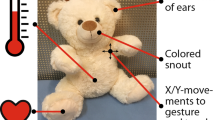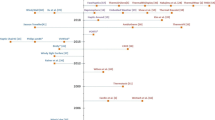Abstract
Thermal sensation is an important channel for getting information. Whereas there has been significant progress in the development of technologies controlling the heat to simulate thermal sensation, there is a lack of understanding about how to utilize it in designing interactive systems. We propose the term “thermal expression” to signify the activity of controlling a particular amount of heat with intention or the heat generated as a result of that activity to crystallize our new view to the heat and a systematic way of thinking about the quality and the structure of the thermal expression. Focusing on the interpersonal communication domain, we explored the expressive quality of the heat through a prototyping approach deploying the heat-based communication devices that we developed in the daily life environment of normal users. We discovered the characteristics of thermal expression and the design opportunities for thermal application development, especially for interpersonal communication. The emotional value and the role of heat as a communication medium are discussed.





Similar content being viewed by others
References
Brandes U, Stich S, Wender M (2009) Design by use: the everyday metamorphosis of things. Birkhauser Verlag AG, Basel
Brown LM, Sellen A, Krishna R, Harper R (2009) Exploring the potential of audio-tactile messaging for remote interpersonal communication. In: Proceedings of CHI 2009, ACM Press, New York, pp 1527–1530
Buchenau M, Fulton Suri J (2000) Experience prototyping. In: Proceedings of DIS 2000, ACM Press, New York, pp 424–433
Dyck PJ, Zimmerman I, Gillen DA, Johnson D, Karnes JL, O’Brien PC (1993) Cool, warm, and heat-pain detection thresholds: testing methods and inferences about anatomic distribution of receptors. Neurology 43(8):1500–1508
Fujita H, Nishimoto K (2004) Lovelet: a heartwarming communication tool for intimate people by constantly conveying situation data. In: Ext. Abstracts CHI 2004, ACM Press, New York, pp 1553
Guiatni M, Benallegue A, Kheddar A (2009) Thermal display for telepresence based on neural identification and heat flux control. Presence 18(2):156–169
Ho HN, Jones LA (2007) Development and evaluation of a thermal display for material identification and discrimination. ACM Trans Appl Percept 4(2):1–24 Article 13
Kroemer KHE, Kroemer HB, Kroemer-Elbert KE (2000) Ergonomics: how to design for ease and efficiency, 2nd edn. Prentice Hall, Englewood Cliffs
Lee W, Kim S, Lim Y, Oh A, Nam T, Kim K (2010) A rapid prototyping method for discovering user-driven opportunities for personal informatics. In: Proceedings ofVSMM 2010, IEEE Computer Society, pp 261–266
Lee W, Lim Y (2010) Thermo-message: exploring the potential of heat as a modality of peripheral expression. In: Ext. Abstracts CHI 2010, ACM Press, New York, pp 4231–4236
Lim Y, Stolterman E, Tenenberg J (2008) The anatomy of prototypes: prototypes as filters, prototypes as manifestations of design ideas. ACM Trans Comput-Hum Interact 15(2):1–27
Nakashige M, Kobayashi M, Suzuki Y, Tamaki H, Higashino S (2009) “Hiya-Atsu” media: augmenting digital media with temperature. In: Ext. Abstracts 2009, ACM Press, New york, pp 3181–3186
Narumi T, Tomohiro A, Seong YA, Hirose M (2009) Characterizing the Space by thermal feedback through a wearable device. In: Proceedings of the 3rd international conference on virtual and mixed reality: held as part of HCI international 2009, Springer, Berlin, pp 355–364
Narumi T, Akagawa T, Seong YA, Hirose M (2009) An entertainment system using thermal feedback for increasing communication and social skills. In: Proceedings of the 4th international conference on E-learning and games, Springer, Berlin, pp 184–195
Oleksik G, Brown LM (2008) Sonic gem: exploring the potential of audio recording as a form of sentimental memory capture. In: Proceedings of BCS-HCI 2008, British Computer Society, pp 163–172
Salzer Y, Oron-Gilad T, Ronen A (2007) Thermoelectric tactile display based on the thermal grill illusion. In: Proceedings of the 14th European conference on cognitive ergonomics: invent! explore! ACM, pp 303–304
Sekuler R, Blake R (2001) Perception, 4th edn. McGraw-Hill Publishing Co, London
Sellen A, et al. (2006) HomeNote: supporting situated messaging in the Home. In: Proceedings of CSCW 2006, ACM Press, New York, pp 383–392
Wakkary R, Maestri L (2007) The resourcefulness of everyday design. In: Proceedings of C&C 2007, ACM Press, New York, pp 163–172
Yamamoto A, Cros B, Hashimoto H, Higuchi T (2004) Control of thermal tactile display based on prediction of contact temperature. In: Proceedings of international conference on robotics and augmentation 2004, IEEE Press, pp 1536–1541
Yang GH, Kyung KU, Srinivasan MA, Kwon DS (2006) Quantitative tactile display device with pin-array type tactile feedback and thermal feedback. In: Proceedings of the 2006 IEEE international conference on robotics and automation, IEEE, pp 3917–3922
Yang GH, Kwon DS (2008) KAT II: tactile diplay mouse for providing tactile and thermal feedback. Adv Robo 22:851–865
Yarnitsky D, Ochoa JL (1990) Studies of heat pain sensation in man: perception thresholds, rate of stimulus rise and reaction time. Pain 40:85–91
Acknowledgments
We would like to thank professor Donald Norman, Hyeon-Jeong Suk, and Seok-Hyung Bae for their valuable comments on this work. We also thank all the participants for their time and concern. This work has been supported by KAIST (Korea Advanced Institute of Science and Technology), ICC (Information Technology Convergence Campus at KAIST), and KMCC (KAIST-Microsoft Research Collaboration Center).
Author information
Authors and Affiliations
Corresponding author
Rights and permissions
About this article
Cite this article
Lee, W., Lim, Yk. Explorative research on the heat as an expression medium: focused on interpersonal communication. Pers Ubiquit Comput 16, 1039–1049 (2012). https://doi.org/10.1007/s00779-011-0424-y
Received:
Accepted:
Published:
Issue Date:
DOI: https://doi.org/10.1007/s00779-011-0424-y




